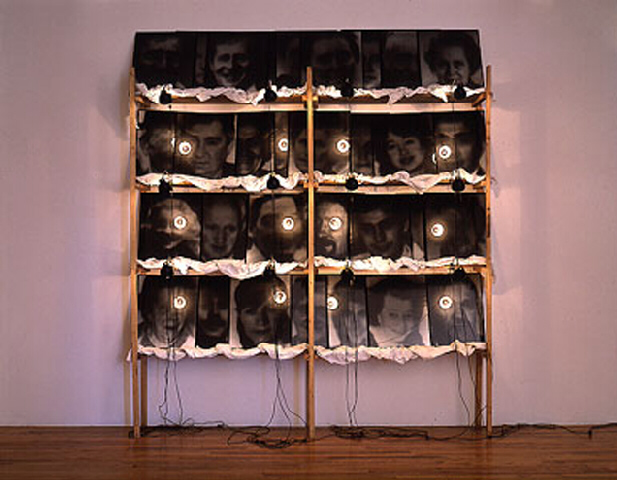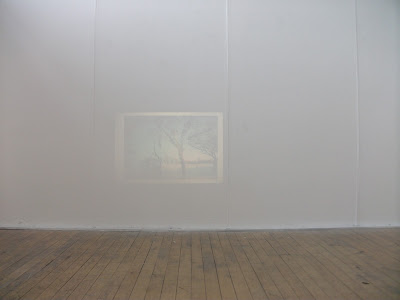Wednesday, 27 April 2011
Tuesday, 26 April 2011
Friday, 22 April 2011
we are sore-eyed scopophiliac oxymorons
insult to injury, jake and dinos chapman, 2004
‘to take a moral stance on violence you have to engage with it and show it. we’ve used goya’s work in our own because it illustrates that paradox. moral taboos are normally demonstrated through utmost transgression.’
Monday, 18 April 2011
boltanski and barthes: what has only occurred once
‘what the photograph reproduces to infinity has occurred only once: the photograph mechanically repeats what could never be repeated existentially’, barthes
‘how does one document what has occurred only once when the event itself is perceived to be a simulation?’, perloff
‘if someone exhibits the photograph of an old lady and the viewer tells himself, today, she must be dead, he experiences an emotion which is not only of an aesthetic order’, boltanski
‘the thing about pictures of dead people is that they are always taken when the subjects are alive, all tanned, muscular and smiling. the photo replaces the memory. when someone dies, after a while you can’t visualise them anymore, you only remember them through their pictures.’, boltanski
for barthes, the reception of the photograph is a kind of rescue operation: the punctum is achieved when its viewer is able to turn the object back into a subject, a sentient and sexual being
for boltanski, such individual transcendence is no longer possible. the referent adheres all right, but that referent is they, not she, and the shock of recognition comes when the viewer recognises the interchangeability of human beings. personal tragedy gives way to a more collective scene of mourning
‘what has occurred only once may recur again and again. or it may not have occurred at all’, perloff
Saturday, 16 April 2011
Friday, 15 April 2011
Thursday, 14 April 2011
Wednesday, 13 April 2011
Tuesday, 12 April 2011
my heart was full
My heart was full of softening showers,
I used to swing like this for hours,
I did not care for war or death,
I was glad to draw my breath.
stevie smith
I used to swing like this for hours,
I did not care for war or death,
I was glad to draw my breath.
stevie smith
Sunday, 10 April 2011
review: rachel whiteread
Rachel Whiteread: Drawings, Tate Britain
It unfolds slowly, gently distinguished by domestic classifications: Tables and Chairs, Baths and Slabs, Beds and Mattresses, Floors. The Tate’s display of Rachel Whiteread’s intimate drawings is appropriately arranged to mirror the diary-like nature of the works, some of which manifest as blueprints for her sculptures, while others are simply a linear imprint of her preoccupation with absence and loss. Sequential but not monotonous, Whiteread’s aesthetic expresses traits descended from the works of Richard Tuttle, Eva Hesse and Agnes Martin; her use of correction fluid especially comparable to Martin’s grids and fields of subtle colour. Study for Floor, 1992, exploits the thick texture of the white fluid, giving the drawing a solidity which is further accentuated by the artist’s idiosyncratic use of graph paper.
Whiteread once described the hidden spaces between floorboards as the intestines of a house. And here, the intestines zigzag across each other, interweaving themselves in a simultaneously regulated and visceral manner. At times, her line is a wandering, searching one, while at others it becomes decisive and resolute, purposefully exposing the disparate nature of humanity.
It is inevitable that comparisons will be made between Whiteread’s drawings and her more prominent sculptural works. Most commonly renowned for casting empty spaces - the underside of chairs, the interiors of houses, the space around baths - Whiteread grapples with notions of void and presence; labouring over something which only exists as air. She is a master at capturing subtle traces of human life amongst barren surroundings: the crusty rust on old bath tubs, stains on discarded mattresses. Her sculptures, often made out of tinted resin and blocks of plaster, are ghosts of negative expanses, reminders of humankind, which appear solid and stable and yet hint at fragility. While the sculptures are beautiful for their physicality, and for providing invisible spaces with substance, the reliance upon the spaces themselves is necessarily restrictive. Whiteread’s Holocaust Memorial in Vienna’s Judenplatz, the cast of an inside-out library, is a monolithic reminder that even inside-out a door is still a door, a book is still a book; these productions of absent spaces merely become what they profess to negate.
Whiteread’s drawings naturally address the same forlorn postulations, but they have a freedom which the sculptural forms lack. To encounter a Whiteread drawing is to witness her sanctuary, a place to which her sculptures cannot take you. Despite the artist’s apparent “expressed wish that none of her drawings should be exhibited alongside her sculptures”, the Tate disregards this, featuring a tinted resin Table and Chair and a black felt wardrobe alongside the drawings, making extended comparison unavoidable. Forms such as keyholes, dribbles of varnish, silver leaf, enamel and elements of collage fill the gallery walls. The substantial use of gouache on vintage advertisements (Untitled, 1998) in which the artist obliterates all information surrounding an armchair, or a rocking chair, render these works brutally but beautifully lonely. Study for Sloping Bed, 1991, completed on tracing paper, puckers and shrivels under the weight of acrylic and ink, the dirty yellow shape like a beacon on the page.
Installed in the last of the three exhibition rooms is a display case of objects collected and chosen by Whiteread herself. Vitrine juxtaposes items gathered from various sources with small casts rejected by the artist; splinters of human life, accumulated and presented as a record of discarded memories. A piece of the Berlin Wall, a bronze cast of an ear, teeth moulds, paper shoes, old brass doorknobs, a squashed metal can and a cast of Peter Seller’s nose are just a few examples of Whiteread’s absent-minded dedication to curiosities. The collection feels no less intimate than her drawings, being another insight into her process of thinking. It is also a persuasive argument in favour of the Tate’s disregard for the artist’s wishes to display her disciplines separately.
Rachel Whiteread’s drawings feel effortless, proving an invaluable relief to the trying physical engagement of her sculptures. They may not contain the fluidity of line that haunts the work of Louise Bourgeois or Chloe Piene, but their conception appears natural, and manages to remain entirely devoid of self-indulgence. The unavoidable comparison does not render the artist’s sculptures redundant, merely burdensome. However, despite her insistence against it, it appears necessary that the two be shown together. They work both against and with each other: the drafted fleetingness of thought complimenting the modeled heaviness of remembrance and loss that characterises her sculptures. Whiteread’s exhibition of drawings is refreshing in its instinctive, fleeting nature. But her sculptures remain in the pit of your stomach, a leaden reminder of everything that has been lost to the past.
8 September 2010 to 16 January 2011
published on line magazine blog, 9th april 2011
http://linemagazine.tumblr.com/
Friday, 8 April 2011
Thursday, 7 April 2011
Sunday, 3 April 2011
Friday, 1 April 2011
Subscribe to:
Posts (Atom)
























































